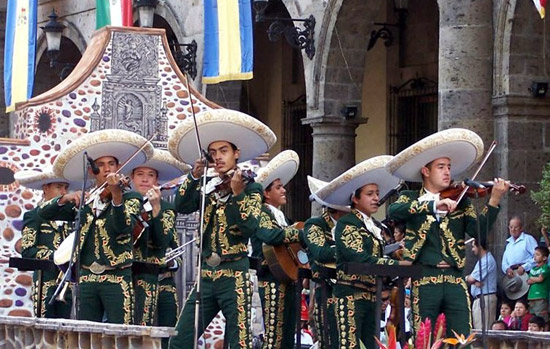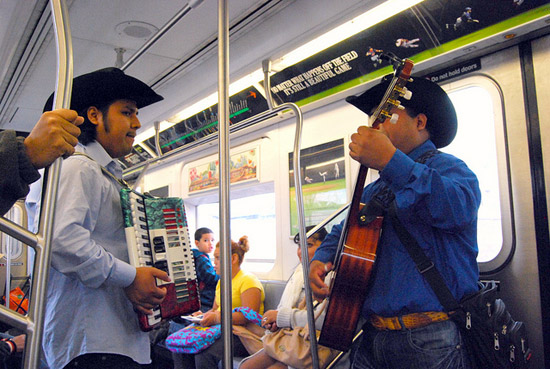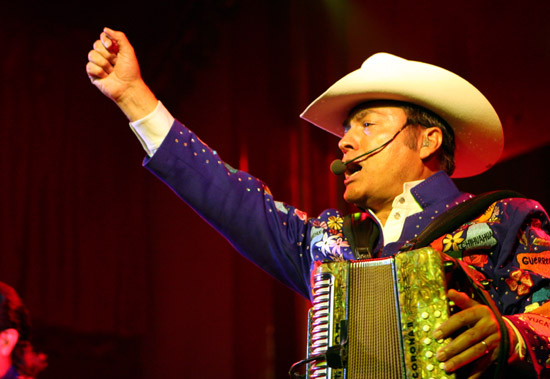Music: Music Overview
Mexico is the most populous Spanish-speaking country in the world, connecting its North American counterparts with Central America below and bordering vast territories of land and sea. Prior to European contact, many ancient civilizations—including the Olmec, Toltec, Teotihuacan, Zapotec, and Maya—evolved on its fertile soils.
Spanish invaders under the leadership of Hernán Cortés conquered and colonized the territory in 1521, when the Aztec Empire’s control over a multitude of Mesoamerican tribes was peaking. Spain’s control of the region allowed for more than three centuries of Catholic hegemony and suppression of native culture; fortunately, however, a portion of Mexico’s indigenous music survived and echoes still as a reminder of the country’s richly artistic past. Musical styles like mariachi, banda, and norteño reflect Mexico’s mestizo history, throughout which collisions between European and indigenous groups spawned vibrant forms of expression elaborated on an eclectic spectrum of instrumentation.
Indigenous Music
Music was employed by native cultures to achieve a wide variety of ends. The Mixtecs (from the Aztec language, Nahuatl, meaning “cloud people”), inhabiting the southern central states of Oaxaca, Guerrero, and Puebla, utilized music and dance to maintain a dialogue with the cosmos. Concerns about the natural environment and well-being of the community were addressed by priest-like figures of elevated social status whose predominantly vocal tradition was transmitted orally between the generations.
The Zapotecs, enemies of the Mixtecs, held open-air celebrations on fixed religious holidays featuring dancing, singing accompanied by instrumental music, and offerings of flowers, birds, and copal to appease their dead in the underworld.
The Maya used music for similar religious purposes, especially during funeral ceremonies, but also to promote and celebrate successful military exploits. Murals unearthed at Bonampak, an ancient archaeological site in the state of Chiapas, suggest that musicians were highly regarded within this civilization as well.
The Huichol of western central Mexico incorporate music, singing, and weeping into peyote rituals performed by shamans—again, prominent figures in the community—in order to establish contact with ancestral spirits.
Under the Spanish
During the colonial era, musical trends followed those from Spain and Europe at large. Thus, Mexico experienced its own baroque and classical periods. Hybrid works combining native Mexican languages and European instrumentation, first appearing in the 16th century, became common throughout the three centuries of Spanish occupation. Many of the surviving musical documents, found in the cathedrals of Mexico City, Puebla, and Oaxaca, were sacred in nature and composed for choirs and orchestras.
Narrative Ballads
Perhaps the most significant legacy left behind by the Spanish—in terms of both its historical impetus and eventual influence—is the corrido. A narrative folk ballad, primarily evolved from the Spanish romance and copla, the corrido usually tells a story with a moral, touching on themes ranging from oppression and the struggles of the lower class, to love and legends of heroism.
Because the musical and linguistic content tend to be relatively simple in nature, the corrido lends itself well to oral transmission and has served a major role as an informational outlet throughout Mexico’s history, especially during the revolution (1910–1917). Curiously, the most recent incarnation of the corrido, the narcocorrido (narco comes from narcotics), continues to relay pseudo-historical information, except that in this case the subject matter is relevant to the United States-Mexico border region (torture, murder, human and drug trafficking, and illegal immigration, for example).
Two- and Three-Beat Dances
The Spanish were not the only Europeans to leave their mark on Mexican music. Many Germans (as well as smaller numbers of Czechs and Poles) began to accumulate around the Mexico-Texas border during the Prohibition Era. Filling the demand for growing industries like brewing, mining, and ranching, these immigrants also introduced the musical styles (such as the waltz and polka) and instrumentation (button accordion) of their homelands.
When the button accordion was combined with the bajo sexto (a 12-stringed guitar popular in northern Mexico), the result was an energetic musical form that would come to be known as norteño (“from the north”), one of the most prominent styles in Mexico today. It is worth noting that Germanic music was first popularized in 1864, when Maximilian I (from Austria, backed by Napoleon III of France) took power. He was frequently surrounded by military marching bands whose brass-based instrumentation surely provided a spark for the explosion of banda music a few decades later.
African Mexican Creole
Veracruz, an eastern state on the Gulf of Mexico, was one of the main points of entry for the conquistadors, as well as for African slaves arriving during the colonial era. It is estimated that well over 500,000 West Africans were imported to replace staggering numbers of natives killed by the Spaniards’ most lethal weapon of conquest: the smallpox virus. The resultant Afro-mestizo population engendered similarly mixed musical traditions like the son jarocho, which features lyrical improvisation and repetition indicative of its Creole and African ancestry.
Centuries after a small number of slaves purchased in Cuba touched shore in Veracruz with their own African-infused musical traditions, rumba and bolero made the same journey across the Caribbean. Cumbia arrived in Mexico City in the 1940s during a collaborative experiment between Colombian singers and a local orchestra director, achieving feverish popularity by the 1980s. Today the genre continues to be reinterpreted in uniquely Mexican ways.
Article written for World Trade Press by Dan DeMento.
Copyright © 1993—2024 World Trade Press. All rights reserved.

 Mexico
Mexico 

